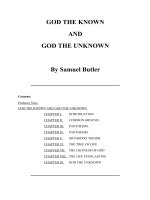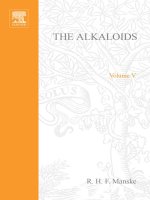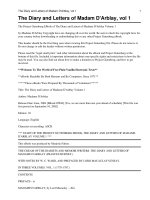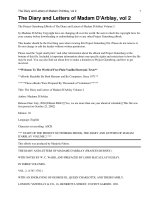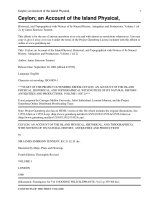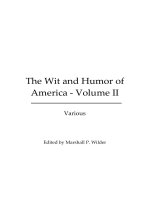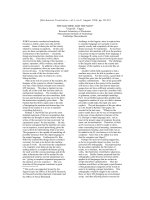God the universe and man volume 6a
Bạn đang xem bản rút gọn của tài liệu. Xem và tải ngay bản đầy đủ của tài liệu tại đây (1.6 MB, 188 trang )
GOD, THE UNIVERSE, AND MAN
BY
WILLIAM MITCHELL
VOLUME 6
GOD,
THE
UNIVERSE,
AND
MAN
GOD,
THE
UNIVERSE,
AND
MAN
For my Dad, who believes that he believes;
and for my family, wherever they may be found.
GOD,
THE
UNIVERSE,
AND
MAN
GOD,
THE
UNIVERSE,
AND
MAN
I do not just want the peace which passeth understanding,
I want the understanding which bringeth about peace.
– Helen Keller
†
I do not seek to understand in order that I may believe,
but I believe in order that I may understand,
for this I feel sure, that if I did not believe,
I would not understand.
– St. Anselm
†
May the inhabitants of earth become one in their hearts,
Unite their plans and designs with the dwellers in heaven!
– Rumi in Teachings of Rumi
†
How can we live in harmony?
First we need to know
we are all madly in love
with the same God.
– St. Thomas Aquinas
†
I have come into this world to see this:
the sword drop from men’s hands even at the height
of their arc of anger
because we have finally realized there is just one flesh to wound.
– Hafiz in Love Poems from God
GOD,
THE
UNIVERSE,
AND
MAN
GOD,
19: ON PANENTHEISM
IN
THE
UNIVERSE,
AND
MAN
RELIGION, PHILOSOPHY,
AND THE
FUTURE
_____________________________________________________________
______________________
___
_
This chapter consists of my Masters’ thesis. It was written in the autumn of 2009, and thus was
written after the majority of these volumes, excepting volumes 5 and 7, the two being written
at roughly the same time, and thus you may perceive similarities. For the most part, however, I
have striven to make sure that they contain different material. This next chapter, 20, will be all
of the information and evidence that I could not include in this thesis due to my word
restriction. I have retained its title, though its original title was “Centering Our Worldview,” and
I have therefore used that for chapter 20.
GOD,
THE
UNIVERSE,
AND
MAN
GOD,
THE
UNIVERSE,
AND
MAN
PANENTHEISM
IN RELIGION, PHILOSOPHY,
AND THE
FUTURE
GOD,
THE
UNIVERSE,
AND
MAN
GOD,
THE
UNIVERSE,
TO “WHEN
AND
MAN
WE KNOW
MORE”
– WILLIAM BLAKE
The Kingdom of Heaven is at hand.
– Jesus Christ
When the community of faith
realizes it has lost its way,
it begins looking forward by looking back.
– Brian McLaren
GOD,
THE
UNIVERSE,
AND
MAN
GOD,
THE
UNIVERSE,
AND
MAN
GOD,
THE
UNIVERSE,
AND
MAN
CONTENTS
CHAPTER ONE: INTRODUCTION – WHAT
CHAPTER TWO: PANENTHEISM
IN THE
CHAPTER THREE: PANENTHEISM
CHAPTER FOUR: PANENTHEISM
IN
IS
PANENTHEISM?
RELIGIONS
PHILOSOPHY
IN THE
BIBLIOGRAPHY
THEOLOGY
PERENNIAL PHILOSOPHY
CHAPTER FIVE: CONCLUSION – PANENTHEISM
NOTES
AND
IN THE
FUTURE
GOD,
THE
UNIVERSE,
AND
MAN
GOD,
THE
UNIVERSE,
AND
MAN
CHAPTER ONE: INTRODUCTION – WHAT
IS
PANENTHEISM?
Our era may be on the very cusp of a revolution in thought that many are not yet
aware of. This revolution is thus one of awareness, an ontological awareness of the nature
and being of things, where and what we are. This possible dawning of awareness is what is
currently coming into our understanding by the term panentheism – though it is also known
variously in established traditions by such names as nondualism and oneness. Everywhere we
look in our culture, some say, we can perceive the notions and aspects of this reality. And its
advocates suggest that its appearance may also be timely, for many separate reasons, but in
the greatest sense because if it proves to be true, or even workable with the world in which
we live today, it is what will prolong us upon this earth. Indeed, advocates of panentheism
claim that it is able to save us in many ways, religiously, politically, ecologically, and more. If it
is as it claims to be, then it is the revelation of the oneness of God, creation, and mankind,
collectively and personally.
GOD,
THE
UNIVERSE,
AND
MAN
John Cooper, author of Panentheism: The Other God of the Philosophers, a book
which reviews the majority of the Western philosophical expressions of this as it has
manifested throughout time, defines panentheism as such that “although God and the world
are ontologically distinct and God transcends the world, the world is ‘in’ God ontologically”
(18). Panentheism literally means ‘all-in-God-ism.’ This is the Greek-English translation of the
German term Allingottlehre, ‘the doctrine that all is in God,’ as Karl Krause, a contemporary of
Schleiermacher, Schelling, and Hegel, coined the term to distinguish his own theology from
theism and pantheism. This specific term wasn’t popularized, however, until it was used by
Charles Hartshorne, a co-founder with A.N. Whitehead of Process philosophy and the
twentieth century’s premier panentheist. The Oxford English Dictionary of the Christian
Church defines panentheism as “the belief that the Being of God includes and penetrates the
whole universe, so that every part exists in Him, but His Being is more than, and not
exhausted by, the universe” (1213). In other words, God is greater than the sum of his/her
parts.
As this thesis will show, many, if not most, religions are inherently or foundationally
panentheistic. For example, the Jewish Kabalistic tradition, the Muslim Sufi tradition, most if not
all of the Hindu philosophical tradition, and nearly all the other mystical traditions of the world
religions are panentheistic.
Indeed, even the orthodox aspects of these traditions or world
religions exemplify panentheism, though most people are currently wholly unaware of such. For
example, St. Augustine, one of founding fathers of the Church and its canon, has this to say in his
Confessions, despite the fact that many would deny he was a panentheist:
I set before the sight of my spirit the whole creation, whatsoever we can see
therein (as sea, earth, air, stars, trees, mortal creatures)….But Thee, O Lord, I
imagined on every part environing and penetrating it, though every way infinite:
as if there were a sea, everywhere and on every side, through unmeasured space,
one only boundless sea, and it contained within it some sponge, huge, but
bounded; that sponge must needs, in all its parts, be filled with that
unmeasurable sea: so conceived I Thy creation, itself infinite, full of Thee, the
Infinite. (Clayton 118)
Hartshorne gives us a more technical definition in his and Philip Reese’s book Philosophers
Speak of God:
GOD,
THE
UNIVERSE,
AND
MAN
God is not just the all of “other” things; but yet all other things are literally in
him. He is not just the whole of ordinary individuals, since he has unity of
experience, and all other individuals are objects of this experience, which is
no mere sum of its objects; moreover, his identifying “personality traits” are
entirely independent of any sort of ordinary actual individuals whatever. To
be himself he does not need this universe, but only a universe, and only
contingently does he even contain this particular actual universe. The mere
essence of God contains no universe. We are truly “outside” the divine
essence, though inside God. (22)
Panentheism differs from both pantheism and classical or supernatural theism in many
important ways. Pantheism makes an ontological identification of God and creation, that is, God
is the sum of the parts, but no more, whereas classical or supernatural theism has them to be
wholly separate, that is, God is not part of the world but is rather another being outside of it that
acts upon it from the outside. Pantheism stresses God’s immanence, while panentheism allows
for immanence but does not downplay God’s transcendence. Panentheism also says that God
does not work miracles in creation or in our lives, but rather works through the very laws that
constitute our world. Often panentheism, in fact its primary metaphor, is that creation is the body
of God, while God’s true being is reserved for what is “beyond” creation yet still one with it.
Panentheism on the whole, as well as all metaphysics, can even be said to be nothing but an
analogy or metaphor, for the truth of the matter – forgive the pun – can never be truly known, for
it is beyond human comprehension. Thus the preposition “in,” as in the world is “in” God, can
only be loosely used. This will be important as we move on in this essay.
John Cooper’s volume, mentioned above, is destined to become a classic as well as a
primer in understanding the history of panentheism, and likewise for a book edited by Philip
Clayton and Arthur Peacocke entitled In Whom We Live and Move and Have Our Being, a phrase
borrowed from the biblical verse of Acts 17:28, and from an ancient pagan source, meaning Greek,
that Paul himself borrowed from. The difference with the latter volume is that it deals with the
issue in a more contemporary setting, being subtitled Panentheistic Reflections on God’s Presence
in a Scientific World. It is a collection of twenty essays by various writers from scientific, religious,
and philosophical persuasions, all discussing our knowledge of things as they stand today as well
as the possible implications for the future, both near and distant.
GOD,
THE
UNIVERSE,
AND
MAN
In his book Original Blessing: A Primer in Creation Spirituality Matthew Fox, a major force
in contemporary theology, says that panentheism is desperately needed by both individuals and
religious institutions today (90). Indeed, Michael Brierley, a chaplain and research assistant to the
Anglican bishop of Oxford, observes that this is already occurring to some depth and thus speaks
of the “panentheistic turn” in our thought and world (Brierley 1). Philip Clayton traces this
modern or contemporary turn in religion and philosophy back to Nicholas of Cusa, a medieval
mystic, scientist, philosopher, and writer, and also to Rene Descartes (2). For the modern era, we
may look towards Alfred North Whitehead’s Process philosophy which is considered a “subset” of
panentheism, and it is making strides and being felt throughout the academic community,
combating both apathetic scholars, that is, those who don’t feel metaphysics has any place in their
field, and postmodernism in general, which feels that metaphysics, which is what panentheism is,
has no place in the world or our thinking at all.
On the other hand, as Brierley further tells us, the “concept has biblical roots, and indeed
is the true ‘orthodoxy,’ and it has been deemed to respond more flexibly than varieties of classical
theism to the concerns of feminists, lesbian and gay, ecological, and ‘economic’ liberation
theologies, the demands of dialogue between science and religion, and the demands of dialogue
between different faiths” (Brierley 4).
If it is true or demonstrable then panentheism, postulating not only the reality of God as
creation but also the presence of God within each and every one of us, also stands to accomplish a
great deal in the field of philanthropy and our relations with other human beings, that is, the
moral aspect of life. This moral potential has another potential outcome, that of the place of the
churches and other religious institutions in the world, for as Brierley put it, if “God’s goodness is at
work more diffusively in the world,” meaning through each of us, “then the church can have no
monopoly on goodness or salvation” (Brierley 6). True or not, some are beginning to envision
monumental changes about to take place, within and without.
Further, some think that such ideas as metaphysics, and panentheism in particular,
attempts to explain away everything or to take the mystery out of life. Indeed, its adherents seek
to do the very opposite, to demonstrate once and for all that the world is ultimate mystery itself,
and likewise is God. While trying to “balance divine transcendence and immanence” (Gregersen
19), panentheists understand that neither creation nor God can be explained, let alone claimed to
be understood, by anybody, not just panentheists. Panentheism, as stated above, is ultimately
just another metaphor for the God-world-human relationship, and according to its adherents it
GOD,
THE
UNIVERSE,
AND
MAN
seems to be the most complete one, if not the one most suited to what seems in fact to be reality.
The fact remains, however, that no matter what model we take, the sheer fact of existence, God’s,
creation’s, and humanity’s seems to elude our comprehension, and perhaps always will. Indeed, a
foundational question of philosophy is, “Why is there something rather than nothing?”
Panentheists say that creation is God’s body, which is immanent, while God’s essence
remains transcendent – another way to put this is that God is the soul of the world. As I will argue
in the final chapter, this is why we should stick to something we do know and can accept, that God
is in each and every one of us. Those who accept it say that this metaphor for, and particularly
this aspect of, the divine-world-human relationship is something that we can believe, somehow,
more readily, and thus act on more readily, than the vague state in which many currently live in
the 21st century. But it will perhaps take the understanding of panentheism in all its ways to get
us to accept God’s being in persons, personally and collectively. As Gregersen puts it, “Only that
which is born out of love is attuned to the love that God eternally is, and only that which is
attuned to divine love can dwell in God” (27).
Another positive doctrine of panentheism is that it more fully explains the reason for evil
in the world and in people, for it leaves us wholly free as individual agents to live out our existence
within God in the way that we choose, without postulating the need for God to interfere in
personal or world events. This is clearly more in line with the scientific perspective. And a third
positive doctrine is that according to the panentheists all God will do is try to influence or
persuade within us through love; and, many argue, this influence and inspiration is the reason that
prayer seems to work in many instances, in appropriate instances (Knight 50). To put this
biblically, it could perhaps be why Jesus was so adamant about prayer and faith, that is, it’s the
only way such can happen, if we open ourselves to the influence of God within ourselves. “As
Drees has noted, it can affirm ‘an ontological form of transcendence… via a scheme of primary and
secondary causes, with the transcendent realm giving effectiveness and reality to the laws of
nature and the material world governed by them…God would be the ground of all reality and thus
intimately involved in every event – though not as one factor among the natural factors’” (Drees
53). Indeed, Paul Tillich, a hugely influential twentieth century philosopher, put it as God being
the Ground of Being, or Being Itself, that all is rooted in and is God himself. He also defined
religion as that which is of ultimate concern, and in the main this nearly always takes the form of
the relationship or being between God, creation, and humanity, individually and collectively.
GOD,
THE
UNIVERSE,
AND
MAN
In discussion of this human ultimate concern we should consider the matter of our free
will. Charles Hartshorne writes that we are “a plurality of active agents within the reality of the
supreme agent” (Fowler 28). Or again, “although there is divine influence of every event, there is
divine determination of no events” (Griffin in Clayton and Peacocke 43). Some argue that this lack
of divine omnipotence limits God in both perception and fact, but it is said that when one comes
to understand the intricacies of the panentheistic model then all arguments seem to fall by the
wayside. They seem to have a very profound and sound understanding of things. For example,
“even divine power cannot create the good without the risk of the evil” (45), yet is it not better
that there be individuals and free choice, rather than God as puppet master and lone personal
mind? God would be very lonely without us.
Many individuals believe that it could be through people that divine revelation happens,
and many panentheists, such as the contemporary intellectual giant David Ray Griffin, contend
that panentheism, which he demonstrates is the true postmodernism, is the revelation that has
been occurring in the “cultural life of the West…through religious, moral, scientific, and
philosophical experience” (36) for quite some time – according to Griffin the past two centuries,
though many say since the beginning of history. One such example of this revelation is the belief
surrounding creation; most panentheists hold, for various reasons, that creation did not have a
beginning, that it is eternal and infinite, while classical theism believes that it did have a beginning
and that it is finite or of limited space, a greater paradox to be sure.
Keith Ward, a comparative theologian and Regius Professor of Divinity at Oxford, makes a
key observation while speaking of the Hindu saint and philosopher Ramanuja, namely that
Ramanuja believes, following the writings of the ancient Hindu Upanishads, that “ultimate reality
(Brahman), individual selves, and the cosmos as a whole are identical” (Ward in Clayton and
Peacocke 62). This is very similar to what Spinoza – historically a pantheist but with many
panentheistic tendencies – called “dual aspect monism.” Philip Clayton rightly observes, however,
that “monism leaves inadequate place for individual difference or the integrity of creation… On
the other hand, a sharp distinction between God and world has led in the modern period to deism
and to the apparent impossibility of divine action” (Clayton 82). Thus, the panentheists argue, the
answer lies in between these two philosophies, and thus also the term nondualism, or also “unityin-difference. The world is neither indistinguishable from God nor (fully) ontologically separate
from God” (82). Similarly, Hartshorne calls his philosophy “di-polar theism.” And this is the major
GOD,
THE
UNIVERSE,
AND
MAN
meaning of the process of what is called Process philosophy, being able to move back and forth
between the divine and human context in understanding or awareness.
Also discussing the relationship between God and the world, Keith Ward speaks on the
well-known European philosopher Georg Wilhelm Friedrich Hegel, whom he sees as approaching
closest to Ramanuja. Of him Ward says, “Hegel sees the universe as an emergent historical
process which is the self-realization and unfolding of Absolute Spirit” (64). For Hegel, God is
incomplete without the world, for it is part of the self-expression of his nature and part of the
divine perfection. And Ward speaks also on Whitehead, for whom, as we saw above, God’s acts
are limited to those which do not undermine human freedom, and in a certain way, whose being is
revealed through human acts. Similarly, the body, or even the material world, are not some
clothing that we put on and take off, rather the body, whether man’s or God’s, are integral parts
of what the whole being in fact is. “The body constitutes, even creates, the self” (68). It is thus
that Ward draws our attention to 2Peter 1:4, that people are “sharers in the divine nature.” This
is what Ward calls “eschatological panentheism” (72), and what mystics around the world, as well
as the Orthodox Church, call by such names as theosis, that is, divinization or deification, or some,
such as Carl Jung and Joseph Campbell and their followers, by the term apotheosis.
Any discussion of panentheism must also engage the scientific aspect or consideration of
the panentheistic worldview. There are many scientists, including Arthur Peacocke, Philip Clayton,
and John Polkinghorne, as well as philosophical and religious panentheists who propound a model
of panentheism called emergence. Emergence is an evolutionary view where God is slowly
revealing himself or has slowly revealed himself through time, beginning from the subatomic and
atomic levels and concluding with consciousness itself, whatever that may be, human
consciousness being the be all end all of God’s purpose in an evolving creation. It may further be
said that God is revealing himself through this slow process of emergence, revealing himself, thus,
to humanity, who is then able to look back to God within and without and partake of revelation.
Some even go so far as to say that “humanity is the transcendence of the immanent, emergent
God” (Morowitz 134). Evelyn Underhill calls this “the nearness yet otherness of the Eternal” (157).
Alfred North Whitehead takes a similar view of creation, arguing that we can envision
things as circles within circles, panentheistic realities within larger panentheistic realities, till we
finally get to God himself. This is something like the ontological argument as formulated by
Anselm in the twelfth century, that is, God is something or a reality which no larger reality can be
thought of. It also has some loose ties to Platonic philosophy. But since God can also be said to be

